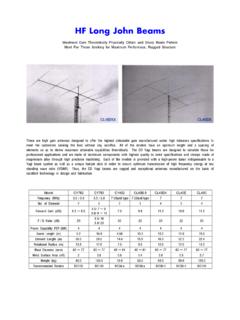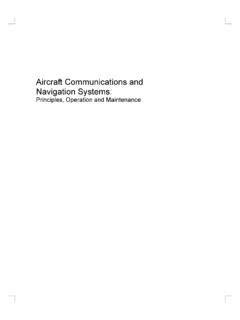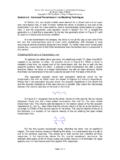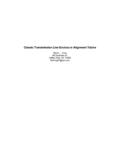Transcription of INSTRUCTION MANUAL - PE2ER
1 LEADER TEST INSTRUMENTSMODEL LIM-870 ANTENNA IMPEDANCE METERINSTRUCTION MANUALLEADER ELECTRONICS CORPR econstructed by PE2ER 1. GeneralThe Leader LIM-870 Antenna Impedance Meter is basically a capacitor type SWR ( standing Wave Ratio) bridge. Both arms of the bridge have been made variable. It is possible to measure radiation resistance and resonant frequency of an antenna, transmission line impedance, approximate standing wave ratio and optimum receiver LIM-870 may be operated from any low power RF source not exceeding Watt. The wide frequency range and portability of a transistor dip meter such as the Leader LDM-815 make it ideal for use with the Antenna Impedance build-in RF amplifier reduces the RF Input power needed for the bridge, to improve frequency SpecificationsAntenna Impedance0-1000 150 MHzRF Power Watt maximum3.
2 Panel ControlsAntenna Impedance Ohms DialThis dial controls a double variable capacitor that is used to balance the bridge and determine antenna impedance in the range 0 to 1000 .Amplifier power switchThis switch controls the power to the build-in RF has the following settings: RF AMP OFF ON and BATT. CHECKI ndicatorThe indicator shows relative RF Bridge unbalance, or voltage of the internal 9 Volt InThe original LIM-870 has two binding posts to feed the antenna impedance bridge with RF power. The modified LIM-870 has a BNC type original LIM-870 has two binding posts to connect the antenna to the impedance bridge. The modified LIM-870 has a SO-239 type antenna socket and two grounded binding switchThe mode switch determines mode of operation in the original LIM-870.
3 It has two positions Direct and AMP. In position Direct, the internal RF Amplifier is modified LIM-870 has no mode-switch; the RF Amplifier can not be Circuit DescriptionThe LIM-870 consists of a two-stage transistor RF amplifier, followed by an RF bridge. See Figure 1. This bridge compares the Antenna Under Test to a reference 50 resistor. An indicator shows the relative unbalance of the bridge. When the indicator has a zero indication, the two legs of the bridge are balanced and the unknown antenna impedance Zx can be read from the capacitor operation of the Antenna Impedance Meter may be understood by referring to the fundamental bridge shown in Figure 2. Here, the variable impedance of the capacitor is shown in the form of a variable resistor consisting of R1 and indicator voltage is given by the following formula:UIND = UR3 UZx = URF x (R3/ (R1+R3) - Zx/ (R2+ Zx))Voltage across the indicator is zero when the voltage over R3 and Zx are equal and in phase.
4 When the bridge is balanced, UIND= 0 VURF x (R3 / (R1+R3) - Zx/ (R2+ Zx)) = 0 This means that:(R3 / (R1+R3) - Zx/ (R2+ Zx)) = 0 and hence R3 / (R1+R3) = Zx/ (R2+ Zx)Form this, it is clear that 1212350 RRRRRZX Resistor R3 has a fixed value of 50 , Zx can be determined by the ratio of R2/R1; the position of the dial on the variable capacitor in the LIM-870 Precautions in operationExcessive input power will damage the RF amplifier and possibly the RF bridge diode and resistor. Never se more power than needed to get full deflection on the the mode switch in position DIRECT, RF Input power must be limited to the mode switch in position AMP, the bridge must only be connected to a low power VFO or dip OperationThe LIM-870 can be operated from any low power RF source, not exceeding Watt.
5 The LDM-815 transistor dip meter makes an excellent driver for it. The LIM-870 and LDM-815 can be screwed together back-to-back to form a compact fully integrated antenna test set. However, a VFO or an even higher powered transmitter may be used if the coupling is decreased sufficiently to prevent overload of the frequencies above 15 megacycles, a one turn loop is usually sufficient for obtaining maximum output from the transistor dip meter. For lower frequencies, a two or three turn loop will be required. The position of the loop generally need only be at a point which produces approximately full scale reading on the Antenna Impedance Meter while the impedance dial is set near the expected impedance and while the Antenna terminals are left open.
6 Because the variable capacitor is linear, nulls towards the high end of the scale will not appear as sharp as those at the lower end. In this case, it may be necessary to increase the coupling to the transistor dipper. For best accuracy of frequency measurements, it is advisable to listen to the transistor dip meter beat against some standard frequency while the instruments are set at the measured reading the following discussion, the RF source will be referred to as generator. Unless otherwise stated, the null is considered as zero meter reading and it must be kept in mind that this is not obtainable unless the measured impedance is resistive which in the case of an antenna or any other circuit made up of inductance and capacitive resistances, means it must be resonant at the frequency concerned.
7 Incomplete nulls indicate the measured impedance is reactive. Before discussing antenna measurements, data on the readings of transmission lines will be first presented because they clearly indicate special characteristics of these lines and because certain definite length of lines will be used with some measurement lines Quarter wave linesTo determine the electrical length of the quarter wave line, connect the line to the antenna terminals of the antenna impedance meter. When using twin lead, do not let it lie on the ground, the floor, or on any metallic objects but see it hangs clear. The case of the instrument should be ungrounded. Set the impedance dial to zero and leave the end of the line open.
8 By varying the generator frequency, find the lowest frequency at which the null occurs. This may be approximated by the standard formula:)()(75mpMHzLVF or )()(246ftpMHzLVF Where:F = Frequency in Mega HertzVp= Velocity of Propagation (of the transmission line)L = Length (of the transmission line, in meter or feet)The frequency indicated by the generator is the that at which the line is one-quarter wavelength long, since the quarter wave open line will appear as a short circuit at its input the generator frequency to any odd number of times the frequency just found and the null will again occur because the above characteristic holds a true at odd quarter , as of general interest, leaving the generator set at the original frequency, connect a non-reactive resistor equal to twice the line surge impedance at the end of the quarter wave section.
9 Rotate the LIM-870 dial until a new null is noted. He generator frequency may have to be slightly retrimmed during this operation. The resistance reading found will be half that of the line surge impedance:ROSZZZ2 Where:ZO = Line Surge Impedance (Transmission Line Property)ZS = Input Impedance (Measured with LIM-870)ZR = Load Impedance (Terminating resistor)Transmission lines Half wave linesConnect the line to the instrument as above but this time short the end of the line. With the LIM-870 dial set at zero, find the lowest frequency at which the null occurs. This will be the half-way frequency of the line, since the half-wave line will repeat whatever is connected at its far end, which in this case is the short-circuit.
10 Any multiple length of the half wave will produce the same result. Now connect a non-reactive resistor of any value within the range of the LIM-870 at the far end of the line. Rotate the dial for the new null, slightly readjusting the generator frequency if required. The indicated value shown on the impedance scale should be that of the test resistor, because as already shown, a half wave line will repeat its lines Surge ImpedanceConnect a section of line, open at its far end, to the LIM-870 and find the frequency at which it is one-quarter wavelength long, as described above. With the generator frequency left set, connect a non-reactive resistor at the far end of the line and find the new null by rotating the impedance dial.








